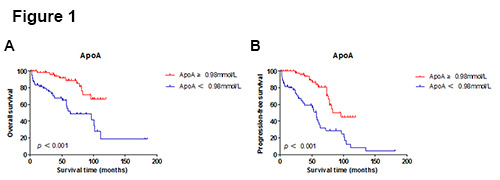
Contributions
Abstract: PB1499
Type: Publication Only
Session title: Chronic lymphocytic leukemia and related disorders - Clinical
Background
The improvement of risk stratification and novel therapeutic targets of chronic lymphocytic leukemia (CLL) are urgently needed. Lipid metabolism is related to the prognosis of hematologic tumors and a potential target for novel therapies of some hematologic malignancies. Apolipoprotein A (ApoA), the major protein of high-density lipoprotein, takes effect on lipid transportation and immunity. Nevertheless, the role of ApoA in CLL has not been explored.
Aims
This study aimed to investigate the potential role of ApoA in the prognosis of CLL patients.
Methods
A total of 150 newly diagnosed CLL patients from January 2010 to December 2019 were enrolled in this study. Survival analyses were performed by Kaplan-Meier curves and univariate and multivariate Cox proportion hazard regression models. Pearson tests, Spearman tests and Chi-square tests were performed to evaluate the correlation between ApoA and other clinical and laboratory parameters.
Results
Kaplan-Meier curves revealed that increased ApoA was associated with longer overall survival (OS) (χ2=14.985; p<0.001; shown in Figure 1A) and progression-free survival (PFS) (χ2=16.190; p<0.001; shown in Figure 1B). Univariate and multivariate Cox regression revealed that ApoA was a significant independent prognostic factor of OS (p=0.028) and PFS (p<0.001). ApoA was related to advanced stages (p<0.001), β2-microglobulin (r=-0.447, p<0.001) and C-reactive protein (r=-0.508, p<0.001).

Conclusion
Our study indicates the prognostic value of ApoA in CLL patients for the first time. ApoA was a favorable prognostic biomarker of OS and PFS in CLL patients. The novel prognostic biomarker may increase prognostic accuracy of CLL.
Keyword(s): Chronic lymphocytic leukemia, Lipid metabolism, Prognostic factor
Abstract: PB1499
Type: Publication Only
Session title: Chronic lymphocytic leukemia and related disorders - Clinical
Background
The improvement of risk stratification and novel therapeutic targets of chronic lymphocytic leukemia (CLL) are urgently needed. Lipid metabolism is related to the prognosis of hematologic tumors and a potential target for novel therapies of some hematologic malignancies. Apolipoprotein A (ApoA), the major protein of high-density lipoprotein, takes effect on lipid transportation and immunity. Nevertheless, the role of ApoA in CLL has not been explored.
Aims
This study aimed to investigate the potential role of ApoA in the prognosis of CLL patients.
Methods
A total of 150 newly diagnosed CLL patients from January 2010 to December 2019 were enrolled in this study. Survival analyses were performed by Kaplan-Meier curves and univariate and multivariate Cox proportion hazard regression models. Pearson tests, Spearman tests and Chi-square tests were performed to evaluate the correlation between ApoA and other clinical and laboratory parameters.
Results
Kaplan-Meier curves revealed that increased ApoA was associated with longer overall survival (OS) (χ2=14.985; p<0.001; shown in Figure 1A) and progression-free survival (PFS) (χ2=16.190; p<0.001; shown in Figure 1B). Univariate and multivariate Cox regression revealed that ApoA was a significant independent prognostic factor of OS (p=0.028) and PFS (p<0.001). ApoA was related to advanced stages (p<0.001), β2-microglobulin (r=-0.447, p<0.001) and C-reactive protein (r=-0.508, p<0.001).

Conclusion
Our study indicates the prognostic value of ApoA in CLL patients for the first time. ApoA was a favorable prognostic biomarker of OS and PFS in CLL patients. The novel prognostic biomarker may increase prognostic accuracy of CLL.
Keyword(s): Chronic lymphocytic leukemia, Lipid metabolism, Prognostic factor


